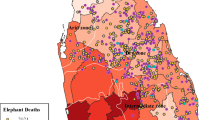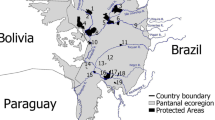Abstract
Construction of the Qinghai-Tibet Railway (QTR) increased the links between inland China and the Qinghai-Tibet Plateau (QTP). The QTR accelerated surrounding tourism, boosted the local economy and led to rapid development of livestock raising. To assess how distance from the railway and different regions has influenced the impact of the QTR on the alpine ecosystem, human footprint maps were produced to indicate human pressures, and the normalized difference vegetation index (NDVI), an index of vegetation greenness, was used to characterize the growth of alpine vegetation. The construction and operation of the QTR have increased human pressures, while the establishment of nature reserves has effectively reduced human pressures. The QTR contributes significantly to the increased human pressures in the Tibetan region compared with the Qinghai region and exerts negative impacts on alpine vegetation. Although the warmer and wetter climate trend has proven beneficial in enhancing alpine vegetation greenness, the declining trend of alpine vegetation has been stronger in regions with more intensive human pressures, especially in the grazing areas and the tourist areas around Lhasa. These results suggest that the impact of the QTR on alpine vegetation in Tibet is greater than that in Qinghai and that the spatial extent of the indirect impact of the QTR in Tibet is confined to approximately 30 km from the railway. These results will provide guidance and a theoretical basis for the protection of the alpine environment on the QTP under intensified anthropogenic influence.







Similar content being viewed by others
References
Bartholomé E, Belward AS (2005) GLC2000: a new approach to global land cover mapping from earth observation data. Int J Remote Sens 26(9):1959–1977. https://doi.org/10.1080/01431160412331291297
Baylis M, Robinson TP, Wint GRW, Conchedda G, Van Boeckel TP, Ercoli V, Palamara E, Cinardi G, D'Aietti L, Hay SI, Gilbert M (2014) Mapping the global distribution of livestock. PLoS One 9(5):e96084. https://doi.org/10.1371/journal.pone.0096084
Burrell AL, Evans JP, Liu Y (2017) Detecting dryland degradation using time series segmentation and residual trend analysis (TSS-RESTREND). Remote Sens Environ 197:43–57. https://doi.org/10.1016/j.rse.2017.05.018
Chen B, Zhang X, Tao J, Wu J, Wang J, Shi P, Zhang Y, Yu C (2014) The impact of climate change and anthropogenic activities on alpine grassland over the Qinghai-Tibet plateau. Agric For Meteorol 189:11–18. https://doi.org/10.1016/j.agrformet.2014.01.002
Chen H, Zhu QA, Peng CH, Wu N, Wang YF, Fang XQ, Gao YH, Zhu D, Yang G, Tian JQ, Kang XM, Piao SL, Ouyang H, Xiang WH, Luo ZB, Jiang H, Song XZ, Zhang Y, Yu GR, Zhao XQ, Gong P, Yao TD, Wu JH (2013) The impacts of climate change and human activities on biogeochemical cycles on the Qinghai-Tibetan plateau. Glob Chang Biol 19(10):2940–2955. https://doi.org/10.1111/gcb.12277
CIESIN (2013) Global roads open access data set, version 1 (gROADSv1). NASA Socioeconomic Data and Applications Center (SEDAC), Palisades. https://doi.org/10.7927/H4VD6WCT
Cong N, Shen M, Piao S, Chen X, An S, Yang W, Fu YH, Meng F, Wang T (2017) Little change in heat requirement for vegetation green-up on the Tibetan plateau over the warming period of 1998–2012. Agric For Meteorol 232:650–658. https://doi.org/10.1016/j.agrformet.2016.10.021
Crutzen PJ (2002) Geology of mankind. Nature 415(6867):23–23. https://doi.org/10.1038/415023a
Cumming GS, Allen CR, Ban NC, Biggs D, Biggs HC, Cumming DHM, De Vos A, Epstein G, Etienne M, Maciejewski K, Mathevet R, Moore C, Nenadovic M, Schoon M (2015) Understanding protected area resilience: a multi-scale, social-ecological approach. Ecol Appl 25(2):299–319. https://doi.org/10.1890/13-2113.1
Cuo L, Zhang Y, Piao S, Gao Y (2016) Simulated annual changes in plant functional types and their responses to climate change on the northern Tibetan plateau. Biogeosciences 13(12):3533–3548. https://doi.org/10.5194/bg-13-3533-2016
DeFries RS, Field CB, Fung I, Collatz GJ, Bounoua L (1999) Combining satellite data and biogeochemical models to estimate global effects of human-induced land cover change on carbon emissions and primary productivity. Glob Biogeochem Cycles 13(3):803–815. https://doi.org/10.1029/1999gb900037
Ding M, Zhang Y, Sun X, Liu L, Wang Z, Bai W (2012) Spatiotemporal variation in alpine grassland phenology in the Qinghai-Tibetan plateau from 1999 to 2009. Chin Sci Bull 58(3):396–405. https://doi.org/10.1007/s11434-012-5407-5
Elvidge CD, Imhoff ML, Baugh KE, Hobson VR, Nelson I, Safran J, Dietz JB, Tuttle BT (2001) Night-time lights of the world: 1994–1995. Isprs J Photogramm 56(2):81–99. https://doi.org/10.1016/s0924-2716(01)00040-5
Fu G, Shen Z-X, Zhang X-Z (2018) Increased precipitation has stronger effects on plant production of an alpine meadow than does experimental warming in the northern Tibetan plateau. Agric For Meteorol 249:11–21. https://doi.org/10.1016/j.agrformet.2017.11.017
Guo R (2016) China’s regional Development and Tibet. Springer, Singapore. https://doi.org/10.1007/978-981-287-958-5
Hansen J, Ruedy R, Sato M, Lo K (2010) Global surface temperature change. Rev Geophys 48:RG4004. https://doi.org/10.1029/2010rg000345
He Y, Lee E, Warner TA (2017) A time series of annual land use and land cover maps of China from 1982 to 2013 generated using AVHRR GIMMS NDVI3g data. Remote Sens Environ 199:201–217. https://doi.org/10.1016/j.rse.2017.07.010
Huang K, Zhang YJ, Zhu JT, Liu YJ, Zu JX, Zhang J (2016) The influences of climate change and human activities on vegetation dynamics in the Qinghai-Tibet plateau. Remote Sens-Basel 8(10):876. https://doi.org/10.3390/rs8100876
Leclerc C, Bellard C, Luque GM, Courchamp F (2015) Overcoming extinction: understanding processes of recovery of the Tibetan antelope. Ecosphere 6(9):1–14. https://doi.org/10.1890/Es15-00049.1
Li J, Chen W, Liu Z (2018a) Geological line selection for the Qinghai-Tibet Railway engineering. Springer, Berlin. https://doi.org/10.1007/978-3-662-55572-9
Li S, Wang Z, Zhang Y, Wang Y, Liu F (2016) Comparison of socioeconomic factors between surrounding and non-surrounding areas of the Qinghai–Tibet railway before and after its construction. Sustainability-Basel 8(8):776. https://doi.org/10.3390/su8080776
Li S, Zhang Y, Wang Z, Li L (2018b) Mapping human influence intensity in the Tibetan plateau for conservation of ecological service functions. Ecosyst Serv 30:276–286. https://doi.org/10.1016/j.ecoser.2017.10.003
Luo L, Ma W, Zhao W, Zhuang Y, Zhang Z, Zhang M, Ma D, Zhou Q (2018a) UAV-based spatiotemporal thermal patterns of permafrost slopes along the Qinghai–Tibet engineering corridor. Landslides 15(11):2161–2172. https://doi.org/10.1007/s10346-018-1028-7
Luo L, Ma W, Zhuang Y, Zhang Y, Yi S, Xu J, Long Y, Ma D, Zhang Z (2018b) The impacts of climate change and human activities on alpine vegetation and permafrost in the Qinghai-Tibet engineering corridor. Ecol Indic 93:24–35. https://doi.org/10.1016/j.ecolind.2018.04.067
Luo L, Zhang Z, Ma W, Yi S, Zhuang Y (2018c) PIC v1.3: comprehensive R package for computing permafrost indices with daily weather observations and atmospheric forcing over the Qinghai–Tibet plateau. Geosci Model Dev 11(6):2475–2491. https://doi.org/10.5194/gmd-11-2475-2018
Ma Z, Liu H, Mi Z, Zhang Z, Wang Y, Xu W, Jiang L, He J-S (2017) Climate warming reduces the temporal stability of plant community biomass production. Nat Commun 8:15378. https://doi.org/10.1038/ncomms15378
Murthy K, Bagchi S (2018) Spatial patterns of long-term vegetation greening and browning are consistent across multiple scales: implications for monitoring land degradation. Land Degrad Dev 29(8):2485–2495. https://doi.org/10.1002/ldr.3019
Niedertscheider M, Gingrich S, Erb K-H (2012) Changes in land use in South Africa between 1961 and 2006: an integrated socio-ecological analysis based on the human appropriation of net primary production framework. Reg Environ Chang 12(4):715–727. https://doi.org/10.1007/s10113-012-0285-6
Pan T, Zou X, Liu Y, Wu S, He G (2017) Contributions of climatic and non-climatic drivers to grassland variations on the Tibetan plateau. Ecol Eng 108:307–317. https://doi.org/10.1016/j.ecoleng.2017.07.039
Pan Y, Yu C, Zhang X, Chen B, Wu J, Tu Y, Miao Y, Luo L (2016) A modified framework for the regional assessment of climate and human impacts on net primary productivity. Ecol Indic 60:184–191. https://doi.org/10.1016/j.ecolind.2015.06.017
Peng CH, Ouyang H, Gao Q, Jiang Y, Zhang F, Li J, Yu Q (2007) Environment - building a “green” railway in China. Science 316(5824):546–547. https://doi.org/10.1126/science.1134134
R Development Core Team (2017) R: a language and environment for statistical computing. R Foundation for Statistical Computing, Vienna
Sanderson EW, Jaiteh M, Levy MA, Redford KH, Wannebo AV, Woolmer G (2002) The human footprint and the last of the wild. BioScience 52(10):891. https://doi.org/10.1641/0006-3568(2002)052[0891:Thfatl]2.0.Co;2
Scholz K, Hammerle A, Hiltbrunner E, Wohlfahrt G (2017) Analyzing the effects of growing season length on the net ecosystem production of an Alpine grassland using model–data fusion. Ecosystems 21(5):982–999. https://doi.org/10.1007/s10021-017-0201-5
Schroter D (2005) Ecosystem service supply and vulnerability to global change in Europe. Science 310(5752):1333–1337. https://doi.org/10.1126/science.1115233
Su MM, Wall G (2009) The Qinghai–Tibet railway and Tibetan tourism: travelers’ perspectives. Tour Manag 30(5):650–657. https://doi.org/10.1016/j.tourman.2008.02.024
Venter O, Sanderson EW, Magrach A, Allan JR, Beher J, Jones KR, Possingham HP, Laurance WF, Wood P, Fekete BM, Levy MA, Watson JEM (2016a) Global terrestrial human footprint maps for 1993 and 2009. Sci Data 3(1):160067. https://doi.org/10.1038/sdata.2016.67
Venter O, Sanderson EW, Magrach A, Allan JR, Beher J, Jones KR, Possingham HP, Laurance WF, Wood P, Fekete BM, Levy MA, Watson JEM (2016b) Sixteen years of change in the global terrestrial human footprint and implications for biodiversity conservation. Nat Commun 7:12558. https://doi.org/10.1038/ncomms12558
Wang C, Guo H, Zhang L, Liu S, Qiu Y, Sun Z (2014a) Assessing phenological change and climatic control of alpine grasslands in the Tibetan plateau with MODIS time series. Int J Biometeorol 59(1):11–23. https://doi.org/10.1007/s00484-014-0817-5
Wang G, Gillespie AR, Liang S, Mushkin A, Wu Q (2015) Effect of the Qinghai–Tibet railway on vegetation abundance. Int J Remote Sens 36(19–20):5222–5238. https://doi.org/10.1080/01431161.2015.1041179
Wang L, D'Odorico P, Evans JP, Eldridge DJ, McCabe MF, Caylor KK, King EG (2012) Dryland ecohydrology and climate change: critical issues and technical advances. Hydrol Earth Syst Sci 16(8):2585–2603. https://doi.org/10.5194/hess-16-2585-2012
Wang X, Ma W, Lang L, Hua T (2014b) Controls on desertification during the early twenty-first century in the water tower region of China. Reg Environ Chang 15(4):735–746. https://doi.org/10.1007/s10113-014-0661-5
Wessels KJ, Prince SD, Frost PE, van Zyl D (2004) Assessing the effects of human-induced land degradation in the former homelands of northern South Africa with a 1 km AVHRR NDVI time-series. Remote Sens Environ 91(1):47–67. https://doi.org/10.1016/j.rse.2004.02.005
Xu W, Zhu M, Zhang Z, Ma Z, Liu H, Chen L, Cao G, Zhao X, Schmid B, He J-S, Jd T (2018) Experimentally simulating warmer and wetter climate additively improves rangeland quality on the Tibetan plateau. J Appl Ecol 55(3):1486–1497. https://doi.org/10.1111/1365-2664.13066
Yeh ET (2005) Green Governmentality and pastoralism in Western China: ‘converting pastures to Grasslands’. Nomadic Peoples 9(1):9–30. https://doi.org/10.3167/082279405781826164
Zhang G, Zhang Y, Dong J, Xiao X (2013) Green-up dates in the Tibetan plateau have continuously advanced from 1982 to 2011. Proc Natl Acad Sci 110(11):4309–4314. https://doi.org/10.1073/pnas.1210423110
Zhang H, Fan J, Cao W, Zhong H, Harris W, Gong G, Zhang Y (2018) Changes in multiple ecosystem services between 2000 and 2013 and their driving factors in the grazing withdrawal program, China. Ecol Eng 116:67–79. https://doi.org/10.1016/j.ecoleng.2018.02.028
Zuo Z, Zhang R, Zhao P (2010) The relation of vegetation over the Tibetan plateau to rainfall in China during the boreal summer. Clim Dyn 36(5–6):1207–1219. https://doi.org/10.1007/s00382-010-0863-6
Acknowledgements
We are grateful to the editors and anonymous reviewers for their constructive and helpful comments, which greatly strengthened this manuscript.
Funding
This research was jointly supported by the National Natural Science Foundation of China (41871065), the National Key R&D Program of China (2018YFB1502800) and the Key Research Project of Frontier Science of Chinese Academy of Sciences (QYZDJ-SSW-DQC040).
Author information
Authors and Affiliations
Corresponding author
Additional information
Communicated by Xiangzheng Deng
Publisher’s note
Springer Nature remains neutral with regard to jurisdictional claims in published maps and institutional affiliations.
Electronic supplementary material
ESM 1
(DOCX 4178 kb)
Rights and permissions
About this article
Cite this article
Luo, L., Duan, Q., Wang, L. et al. Increased human pressures on the alpine ecosystem along the Qinghai-Tibet Railway. Reg Environ Change 20, 33 (2020). https://doi.org/10.1007/s10113-020-01616-7
Received:
Accepted:
Published:
DOI: https://doi.org/10.1007/s10113-020-01616-7




